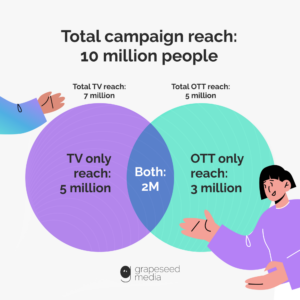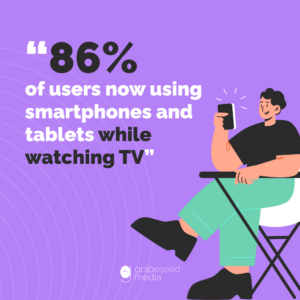Connected TV, or CTV as it’s known in the programmatic advertising world, refers to the increasingly popular smart TV sets—or any TV set that is connected to the internet—that are taking over households around the world. It’s been estimated that there will be 121 million US households with CTVs by 2027, whether that’s through smart TVs, streaming devices (Amazon Fire Stick, Roku etc), or a gaming console.
And these internet connected TVs bring another way for marketers to advertise their brands. If you’re a marketer that’s tracking the reach of your adverts, you need to be familiar with the concept of incremental reach for both live TV and digital. Here, we’ll go through exactly what it is, why it’s so important, and how you can measure it.
What Is Incremental Reach?
In marketing, reach refers to the size of the audience segment, or the population percentage, that sees a linear TV advertising campaign. For example, if an advert engages 10 million people in their 20s, when the total population of this demographic is 20 million, the campaign reach is 10 million, or 50%.
Incremental reach refers to the additional audience that is engaged with an over-the-top (OTT) advert, as well as the traditional linear television advert.
If we go back to our previous example, of the 10 million people that saw the campaign, 7 million saw the advert on linear TV, while 5 million were targeted by OTT video content. The audience that saw both the linear ad and the OTT ad was 2 million people. This means that the advert reached an incremental 3 million viewers through the OTT advertising.

Incremental reach refers to the additional audience of a new marketing channel—this typically refers to the CTV and over-the-top (OTT) advert audiences over traditional TV advertising.
These CTV adverts are typically found on the connected TVs and streaming services, and are made up of:
- Video adverts
- Sponsored content
- Banner adverts
Why Should You Track Incremental Reach?
The digitalization of the way we take in media and entertainment has transformed the media landscape. In order to get your message across to your audience, you need to carefully think about how they’re interacting with the media and where you should be targeting your adverts.
And as more and more people turn away from linear television and towards streaming and CTV, it’s a good idea to follow suit with your own advertising campaigns.
Tracking your incremental reach allows you to better understand the success and reach of your campaign—especially when you’re utilizing multiple channels. It allows you to see which channel is performing better for your campaign and reaching your target audience more effectively. This will allow you to tweak your strategy to ensure your campaign is targeting the right audience at the right time.
How To Measure Incremental Reach
There are different ways advertisers can measure incremental reach in order to optimize strategies. In order to effectively analyze the data, you’ll need to set up your tracking and know exactly what KPIs you’re tracking. We’ll go through the three most common types of incremental reach measurement strategies.
Randomized Control
Randomized control versus exposed testing is one of the main approaches to measuring incremental reach in CTV. This method requires you to carefully segment an audience and match it to a control group that matches the audience attributes. This allows you to target CTV ads to one audience, while ensuring the control group doesn’t receive the ad, relying solely on linear television advertising. This allows you to track the incremental reach success, allowing you to make any tweaks as necessary to drive engagement.
Randomized control can also be an ongoing test, which doesn’t need much maintenance, so you can continually track the effectiveness of your adverts.

Representative Data Set
This is another way to measure the success of incremental reach, and relies on leveraging a substantial television-based dataset. By comparing a group exposed to your CTV ad against a similar population, you’re able to compare the effectiveness of your ads based on factors such as timing. Scraping and analyzing the data allows you to make tweaks to the CTV campaign, ensuring you hit any demographics that may have missed the television advert.
Omniscreen Targeting
Omniscreen targeting refers to a few different targeting options.
-
Retarget underexposed audiences
Audiences that may typically not watch traditional linear television, such as “cord-cutters” and casual TV watchers who may keep it on as background noise should be targeted and prioritized in your campaigns. This type of audience is considered underexposed, and will help to increase your incremental reach while also targeting audiences who may otherwise not see your traditional TV advert.
-
Consider tentpole marketing strategies
Tentpole marketing involves tapping into the cultural zeitgeist, focusing your efforts on events, holidays, seasons, and other big cultural moments to capitalize on the trend. Rather than create a traditional TV advert that focuses on these trends, consider creating a digital strategy that targets your audiences across various channels, including CTV. This allows you to target audiences, regardless of where they are or what time it is.
-
Leverage second screen targeting
As well as targeting smart TVs, your incremental reach can be measured against mobile devices, including laptops, tablets, and smartphones. Second screen is a growing trend, with a reported 86% of users now using smartphones and tablets while watching TV. Ensuring your ads are appearing elsewhere online, as well as on streaming services and linear TV, will widen your reach and ensure your campaigns are seen and users are driven to your target page. Second screening also improves brand awareness and recognition, as users are exposed to your adverts more frequently, and boosts your incremental reach.

-
Establish KPIs
Your CTV advertising efforts need to be tracked in order to accurately measure your incremental reach. You should clearly define your goals and audience, and carefully set your campaign dates and assets. Having your campaign set up carefully means you’ll be able to properly track your wins and see where you can make any necessary tweaks and adjustments to your campaign.
CTV Advertising With Grapeseed
Gaining the most return on your investment and the widest incremental reach should be the most important factors of your digital advertising campaign. Being able to create a strategy that harnesses the power of CTV ads is easy when you know how.
Our team are experts in creating technical, data-led strategies, taking control of your digital programmatic advertising campaigns, so you can focus on the running of your business and servicing your clients.
If you’d like to learn more about how Grapeseed’s CTV professionals can help your business, get in touch. We’re always happy to help.

